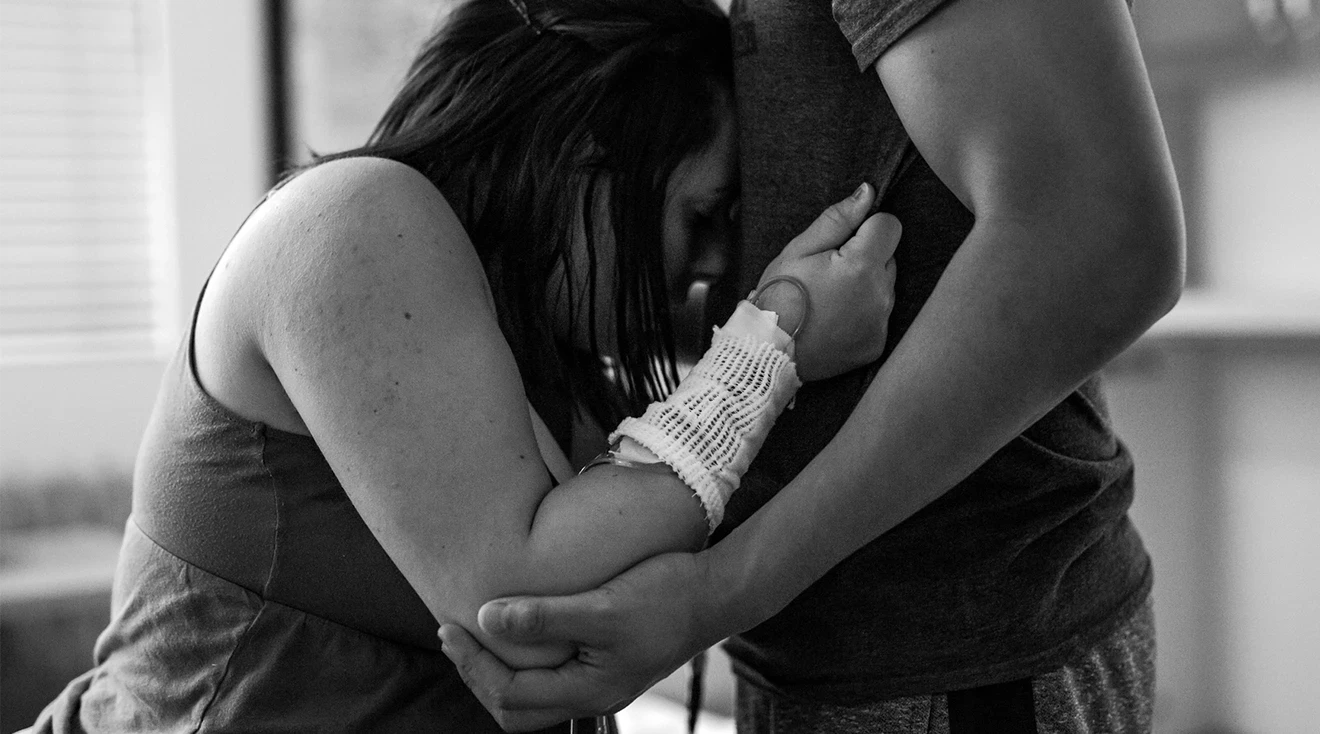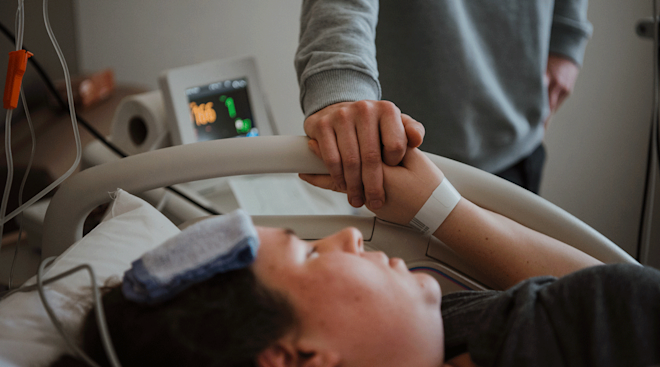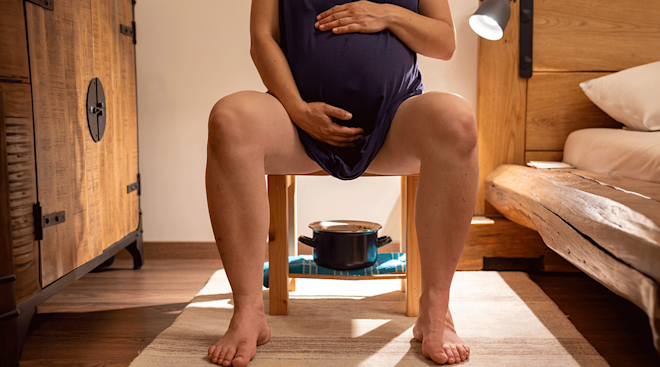9 Ways to Support Your Birthing Partner During Labor and Delivery
Being a support person during a loved one’s birth experience is a privilege and an honor, but it’s also a weighty task, full of obligation and responsibility. Whether you plan to be in the delivery room with your partner (or a close friend), you’ll play an integral part in their birth experience.
During labor and delivery, you’ll set the tone and vibe, act as an advocate and offer continuous physical and emotional support. Suffice it to say that your presence isn’t just a comfort; it can make a major difference in the overall experience and outcome. Kecia Gaither, MD, director of perinatal services and maternal fetal medicine at NYC Health + Hospitals in the Bronx, says that the benefits of a support person are evident and measurable: A laboring parent with an active support person may have a reduced need for pain-relieving medication, a shortened labor length and a greater chance of having a spontaneous vaginal delivery. What’s more, birthing people have more positive feelings about childbirth with a support person present, she says.
But there’s more to being a support person than simply showing up. You’re going to want to educate yourself so that you can use your voice, ask questions and empower your laboring loved one. Here are nine ways to be the ultimate source of support.
Know your stuff ahead of time, so that you’ll be ready as baby’s due date approaches. If your partner has a birth plan, go through it together, and ask them what their expectations are of you.
Take a proactive approach to tackling this steep learning curve: Attend classes, read books and listen to podcasts that highlight the physical and mental aspects of labor, delivery and becoming a parent.
Finally, ask friends and other birth support people about their experiences, including what helped and what didn’t. Listening to stories and taking advice from people you know can make the impending event feel more real, and give you a better grasp on what the experience is really like on both sides of the birthing bed.
The hospital can feel sterile and stressful and bright and loud; it’s your job to promote peace and create a soothing environment inside the walls of your partner’s labor and delivery room. Discuss the desired ambiance in advance so you can better understand your assignment.
One way to quell the chaos? Dim the lights. Play soothing music (or whatever tunes your partner prefers) and speak in a quiet, hushed tone. It may feel a bit silly at first, but this will encourage others in the room to do the same. “You are the gatekeeper of the space,”says Abigail Morrissey Riordan, a postpartum doula and holistic care provider. That means you set the expectation for everyone else.
Cece Peace, a certified professional birth doula and mom of three, suggests hanging twinkle string lights or placing battery-operated tea lights around the room. She also likes using an essential oil diffuser to add to the atmosphere. (Of course, check with your hospital to make sure you’re allowed to have one in the room). “My go-to essential oils are lavender and peppermint,” she adds.
Things can happen suddenly in the delivery room. When the pace picks up, you may need to take a more proactive role in gathering information from your partner’s medical team. Don’t hesitate to ask any and all questions about what’s happening and, when making decisions, be clear on the birth plan and speak up as needed.
You might feel pressured or on the spot, but outside of emergencies, Peace says there’s usually time to think before making a decision about how to move forward with medical interventions. She suggests using the acronym BRAIN for decision-making during labor:
- B - What are the benefits?
- R - What are the risks?
- A - Are there alternatives?
- I - What does your intuition say?
- N - What if we do nothing?
This can help you work through the facts and hypotheticals in a way that takes logistics and emotions into account.
Of course, emergencies do happen. If this is the case, try to stay calm and remind your partner that they’re safe and in good hands. “Once everyone is stable and secure, I’d be ready to hold space for processing and helping them to recount the events,” says Peace.
Giving birth is a lot of work. Physical touch can help your partner in the more challenging and painful moments of labor and delivery. Gaither says that assisting with back support and massage are simple ways to physically help. Even giving your partner a hug or holding their hand provides thoughtful touch and physical attention that can take the edge off.
Helping your partner transition positions while laboring is another important way to physically be there for and with them. Jessica Lagrone, a certified birth doula and the co-founder of Balanced Families, recommends trying a “slow dance" position: “It’s perfect for creating an intimate environment while remaining upright.”
Beyond chanting the word “push,” there are ways to promote progress and positivity in the delivery room. Peace suggests using words of affirmation; you can even write them down and hang them on the walls as a focal point for your partner. Some suggestions include:
- “You’re so strong.”
- “You can do hard things.”
- “You’re doing this!”
- “You’re one step closer to meeting baby!”
Breathing techniques can be immensely helpful during labor and delivery. Lagrone says that the main benefit of a deep, calming breath is that it keeps the person in labor relaxed. “Of course, this is really hard to do when contractions are at their peak, which is where a birth partner can help,” she says. “Get at eye level, model how to breathe and encourage them to breathe with [you].” This level of rhythmic connection can restore a sense of peace in an otherwise stressful situation.
You can’t be there for someone if you’ve ignored your own well-being. Don’t wait until the last minute to prepare. Pack a hospital bag for yourself so it’s ready for delivery day. (Remember to bring snacks, drinks, a water bottle, fresh clothes, a phone charger, earbuds and anything else you might need while away.)
Make arrangements for pets, children and things at home. Inform your employer and delegate someone to take care of other loose ends. Do everything beforehand, so your future self can focus on supporting your partner.
While at the hospital, be proactive with your basic needs, and rest when your partner does. “Make sure you take time to tend to yourself, and take breaks should you need it,” reminds Morrissey Riordan. This will ensure you’ll be ready and on your A-game when it’s finally go time.
What’s more, don’t complain. Hospitals aren’t necessarily the most comfortable of places, and the birthing process can get long; the minutes will quickly turn into hours (or days). Try to remember that this isn’t about you. Do your best to remain calm and even, and focus on the present moment.
Don’t forget to take photos of the experience on your phone or with a professional camera (if your partner gives consent). “Snapshots of your partner breathing through contractions, moving around the room, getting counter pressure from her partner, taking sips of water or bites of food are great,” says Lagrone, adding that video clips help capture the mood of the room as labor progresses. Of course, don’t let your role as a photographer infringe on the more important job of being a support person.
Bringing baby into the world is exciting for everyone! Family and friends are eagerly awaiting updates. Since you’re the go-to person, you’re responsible for relaying information to whoever needs it. Of course, you’ll want to discuss the communication plan beforehand and respect your partner’s wishes.
If there are people that you’ll need to update, write down their names and numbers ahead of time. A group chat might work well for this, but a good rule of thumb is to let loved ones know you’ll only be giving updates, not answering questions or having full conversations. Your attention is needed in the delivery room; everyone else can wait.
Support can look different for every birthing person. Allow your partner to communicate their needs in the moment, and do your best to provide the love and empowerment they’re looking for. Being present physically and emotionally is a good start. “It’s such a great honor to hold space for the fears and excitement, and witness the absolute wonder that bringing a child into this world is,” says Peace. Try to enjoy this incredible experience together.
Please note: The Bump and the materials and information it contains are not intended to, and do not constitute, medical or other health advice or diagnosis and should not be used as such. You should always consult with a qualified physician or health professional about your specific circumstances.
Plus, more from The Bump:
Kecia Gaither, MD, is director of perinatal services and maternal fetal medicine at NYC Health + Hospitals in the Bronx. She received her medical degree from SUNY Health Science Center in Syracuse.
Jessica Lagrone is a certified doula childbirth educator, and the co-owner of Balanced Families.
Abigail Morrissey Riordan, is a postpartum doula and holistic care provider, specializing in integrative education and support for people in the postpartum stage.
Cece Peace, is a certified professional birth doula and mom of three.
Cochrane Library, Continuous support for women during childbirth, July 2017
Learn how we ensure the accuracy of our content through our editorial and medical review process.
Navigate forward to interact with the calendar and select a date. Press the question mark key to get the keyboard shortcuts for changing dates.




















































